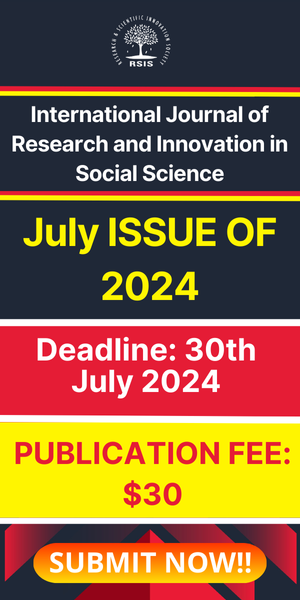Accessibility to Job Locations in Calabar Metropolis, Cross River State, Southern Nigeria
- July 14, 2018
- Posted by: RSIS
- Category: Geography
International Journal of Research and Innovation in Social Science (IJRISS) | Volume II, Issue VI, June 2018 | ISSN 2454-6186
Accessibility to Job Locations in Calabar Metropolis, Cross River State, Southern Nigeria
Inah E. Okon.1*, Tonye T.I.T Ojoko1
1Department of Geography & Environmental Science, University of Calabar, Calabar, Nigeria
*Corresponding Author: Inah E. Okon.
Abstract-The aim of this paper was to examine the level of accessibility to job locations for the urban poor in Nyangasang and Anantigha areas of Calabar Metropolis. Travel diary was used in combination of the questionnaire with a success rate of 89.8 percent (449) for the transport data and socio-economic data from respondents. There were selected using the stratified sampling technique. Kernel density analysis in a GIS environment was employed to estimate the number of jobs located per 1000 m2. SPSS provided the tool for analysis of statistical data leading to test of formulated study hypothesis. The study confirmed that there was significant relationship between transport mode to job locations and available transport options for residents in the study area, F(1, 431) = 18.181, p < .005. Different levels of accessibility were undertaken using travel options to predict the number of jobs that can be located per 1000 m2. Interesting results were obtained to show the different level of influence each transport variable has on accessibility to jobs in the study area. It is clear from the analysis that the current transport scenarios determine the location of jobs in the study area, yet the current public transport realities do not benefit the poor, neither is the current internal urban spatial structure. To improve the benefit of urban transport for the urban poor, more attention needs to be paid on redesign of roads and other complimentary infrastructures to enhance sustainable public transport system that is efficient, available, and affordable.
Key words: Accessibility; Urban poor; Job locations; Modal split
I. INTRODUCTION
Accessibility is a fundamental measure of the benefits of urban life. It measures the end benefit of the integrated transportation and land use system indicating how many destinations (generally jobs but also shops, schools, entertainment, and recreation) can be assessed in a given time using a given mode of transport. Increasing accessibility-bringing people, opportunities and goods within easy reach of each other-has always been the fundamental role of cities. Accessibility plays an important role in policy making, and is a central concept used in a number of scientific disciplines such as transport planning, urban planning, and geography (Geurs & Ritsema, 2003). There are three main perspectives on the measurement of accessibility.


